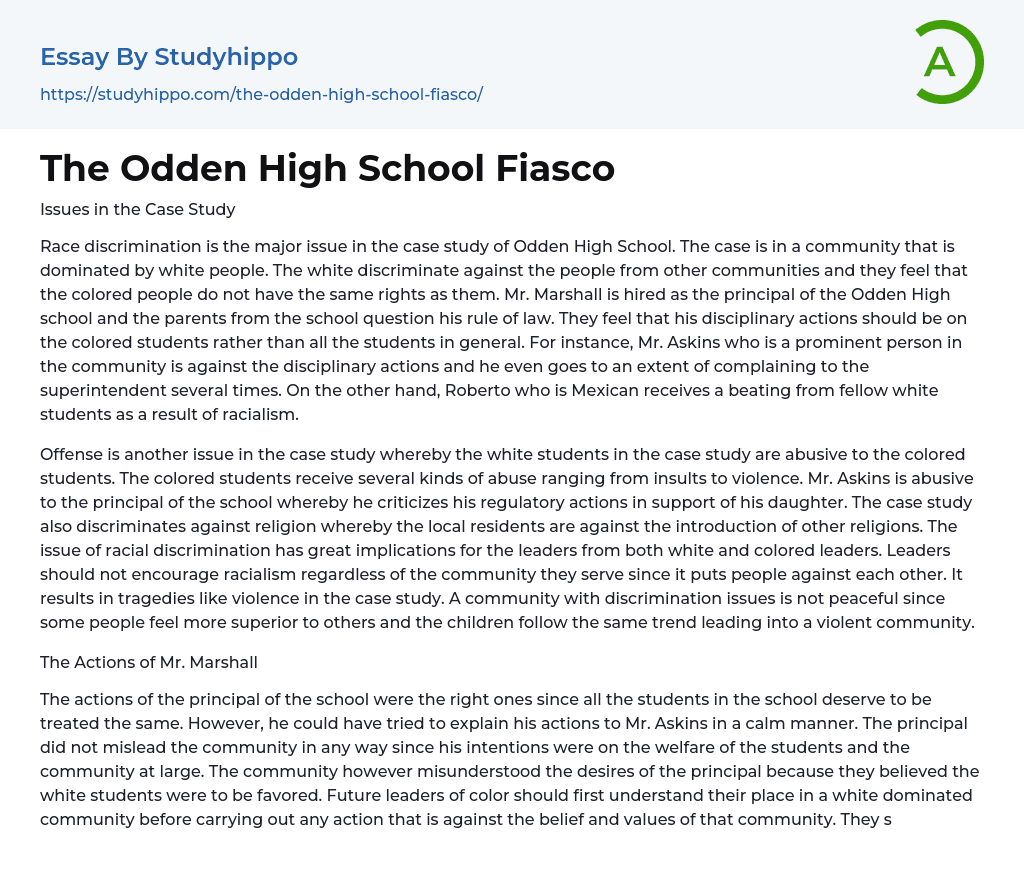Issues in the Case Study
The case study of Odden High School revolves around racial discrimination within a predominantly white community. Individuals from other communities face discrimination due to their race, as the white population believes that people of color do not possess equal rights.
Mr. Marshall is appointed as the principal of Odden High School and faces criticism from parents regarding his enforcement of disciplinary actions. These parents believe that his approach should focus specifically on students of color rather than applying to all students in general. As an example, Mr.
Askins, a prominent person in the community, vehemently opposes the disciplinary actions and has repeatedly lodged complaints with the superintendent. Conversely, Roberto, a Mexican student, becomes a victim of racial violence perpetrated by fellow white students. Offense is also prevalent in the case study, with colored students being subjected to various forms of
...abuse, ranging from verbal insults to physical violence, by their white counterparts.
Mr. Askins is verbally abusive towards the school principal, expressing his disapproval of the principal's decisions that benefit his own daughter. The case study also highlights discrimination based on religion, as the local residents oppose the introduction of different religious beliefs. The problem of racial discrimination has significant consequences for both white and non-white leaders. Leaders should refrain from promoting racial division within the communities they serve, as it fosters animosity among people. Such division can lead to tragic incidents, such as violence, as seen in this case study.
A community that encounters prejudice does not promote peace as it encourages a feeling of superiority among specific individuals, ultimately resulting in a violent community.
Mr. Marshall's Conduct
While the principal's behavior was warranted in guaranteeing
fair treatment for all students at the school, he could have endeavored to peacefully communicate his actions with Mr. Askins. It is crucial to acknowledge that the principal did not mislead the community in any way, as his intentions were centered on the welfare of the students and the entire community.
Despite the misconception that the principal favored white students, it is crucial for future leaders of color to acknowledge their position in a predominantly white community. Before taking actions that contradict the community's beliefs and values, leaders should first comprehend and navigate this situation. Moreover, these leaders should openly communicate their strategies and plans before implementation to prevent disapproval. Conversely, white leaders should recognize that discrimination based on skin color is baseless as it is only a superficial distinction.
Leaders from different racial backgrounds demonstrate fairness towards individuals, regardless of their varying skin tones. This sets a notable example for future white leaders. Particularly, Latino school leaders in African American communities are treated fairly and protected from discrimination. It is imperative for upcoming leaders to uphold this inclusive approach. In contrast, the situation is reversed for African American leaders in Latino communities, who face bias due to disparities in skin color. To address this issue, these communities need to work towards changing this unjust pattern.
The issue of racism holds great importance, especially for African American leaders and students who face discrimination from different racial groups. Nevertheless, African American communities do not discriminate against other races and offer valuable insights.
An Inversion of Roles in the Case Study
If the scenario were flipped, with either an African American or Latino community, significant differences would emerge. The principal would receive
positive feedback, and the community would express satisfaction with the alterations.
In contrast to the case study, white students would receive privileges in African American or Latino communities. Throughout US history, people of color have faced discrimination while white individuals have always enjoyed privileges. Thus, it is unlikely for a white student to encounter discrimination in any US community. However, white individuals are generally perceived as intelligent and their ideas as teachers would be positively received regardless of the community they teach in. African American and Latino communities have accepted their subordinate position in the US and view whites as dominant. Consequently, they would not resist a white teacher even if teaching within their own community.
They firmly support color equality, making it difficult for them to discriminate against a white teacher who strives for positive change and equal treatment regarding color issues. Conversely, if the situation were reversed, parents would flock to the school to commend the principal's initiatives and encourage him to continue enforcing disciplinary measures. This would inspire him instead of causing torment. If the entire scenario were reversed, the outcomes would be entirely different, and the community would rejoice in the transformations.
- Plans after High School essays
- High School Experience essays
- Domestic Violence essays
- Gun Violence essays
- Media Violence essays
- Video Game Violence essays
- Violence Against Women essays
- Violence in Video Games essays
- Youth Violence essays
- Classroom essays
- College essays
- E-Learning essays
- Elementary School essays
- Examination essays
- Graduate School essays
- High School essays
- History Of Education essays
- Homeschooling essays
- Kindergarten essays
- Middle School essays
- Public School essays
- School essays
- Single Sex Schools essays
- Special Education essays
- Student essays
- Teacher essays
- University essays
- Vocational Education essays
- Antisemitism essays
- Black History Month essays
- Black Lives Matter essays
- I Have a Dream essays
- Ku Klux Klan essays
- Malcolm X essays
- Martin Luther King essays
- Miscegenation essays
- Racial Inequality essays
- Racial Segregation essays




